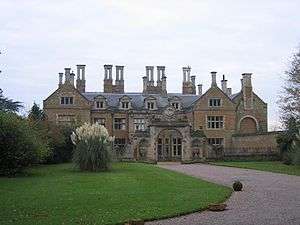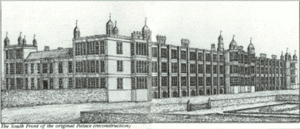Holdenby House
Holdenby House is a historic country house in Northamptonshire, traditionally pronounced, and sometimes spelt, Holmby. The house is situated in the parish of Holdenby, six miles (10 km) northwest of Northampton and close to Althorp. It is a Grade II* listed building.[1]

History
The house was completed in 1583 by the Elizabethan Lord Chancellor, Sir Christopher Hatton, who refused to sleep a night in the mansion until Queen Elizabeth I had slept there. It was one of the largest prodigy houses of the Tudor period, rivalling in size both Audley End and Theobalds, and was reputed to occupy approximately 78,750 square feet (7,300 m²), although this probably included the two great courtyards around which it was built. The facades were symmetrical, with mullioned windows and open Doric arcades, reflecting the Renaissance style of architecture gradually spreading from Italy. Hatton died in 1591.[2]
In 1607 the mansion was bought by Elizabeth's successor James I. His wife Anne of Denmark stayed in August 1608.[3]
In February 1647, after the First English Civil War, Charles I was brought to Holdenby by the Scots and handed over to the English Long Parliament. He remained a prisoner there until June 1647 when Cornet George Joyce seized him and took him to Newmarket in the name of the New Model Army.[4] Parliament later sold the estate to Captain Adam Baynes, who demolished the house almost entirely except for a small domestic wing.

In 1709, Holdenby was bought by the Marlborough family who in turn sold it to their kin the Clifden family whose descendants in the female line, the Lowthers, still own the property as of 2014. The Clifdens had a new house built in the style of the older mansion, incorporating the older mansion's remains but being only about one eighth of its size.[5]:261 The first phase of the new house was designed by the architects Richard Carpenter and William Slater and built in 1873–75.[5]:261 A second phase was designed by Walter Mills and built in 1877–78.[5]:263
As of 2014, all that remains of Hatton's great house are two Grade I listed archways and the kitchen wing incorporated into the Victorian rebuild, now standing on a lawn, which once gave access to the courtyards; a near-identical third arch bears the date 1659 and so must have been built for Baynes, the Cromwellian owner.[5]:263
The gardens are listed Grade I.[6]
A door salvaged from the demolition of Holdenby palace is believed to be inside Morningside cottage, a grade II listed building in the nearby village of Creaton.[7]
Filming location
In July 2011, the exterior of Holdenby House was transformed as the location of Satis House in BBC One’s adaptation of Charles Dickens’s Great Expectations. Parts of the film Biggles (1986) were filmed at Holdenby.[8]
Functions and visits
The estate is a private residence which is available as a corporate and wedding venue and is opened to the public on a limited and paid basis.[9] Other activities include a falconry centre.[10]
References
- Historic England. "Holdenby House (Grade II*) (1067053)". National Heritage List for England. Retrieved 15 March 2016.
- "The history". Holdenby House.
- William Fraser, Elphinstone Family Book, vol. 2 (Edinburgh, 1897), p. 158.
- Austin Woolrych (2004). Britain in Revolution: 1625-1660, Oxford University Press, ISBN 0-19-927268-9, ISBN 978-0-19-927268-6. Page 363
- Pevsner, Nikolaus; Cherry, Bridget (1973) [1961]. Northamptonshire. The Buildings of England. Harmondsworth: Penguin Books. pp. 261–263. ISBN 0-14-071022-1.
- Historic England. "HOLDENBY HOUSE (1001035)". National Heritage List for England. Retrieved 11 September 2015.
- "Historic England listed building entry for Morningside cottage".
- "Biggles (1986): Filming Locations". IMDb. Retrieved 15 March 2016.
- Visitor Information at official site. Accessed 17 October 2014
- Falconry at official website
Further reading
- Whyte Melville G. J. 'Holby House' Ch.XXVII of the historical novel Holby House: a Tale of Old Northamptonshire, written in 1859, reconstructs the house's appearance during the captivity of Charles I.
External links
- Holdenby House Official Website